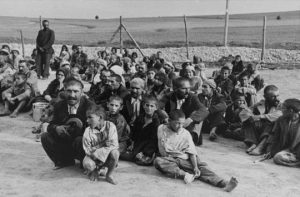The Roma genocide
Europe’s Roma and Sinti people (often labelled as ‘Gypsies’ historically) were targeted by the Nazis for total destruction.

Romani prisoners in a camp © USHMM
Historians estimate that up to 500,000 Roma and Sinti people were murdered by the Nazis and their collaborators. Many more were imprisoned, used as forced labour or subject to forced sterilisation and medical experimentation.
Roma and Sinti men, women and children were targeted for persecution and imprisonment, with a specific focus on clearing Berlin before the city hosted the Olympic Games in 1936. As World War Two began, the genocide of the Roma and Sinti people intensified. Roma and Sinti people were deported to ghettos including Łódź and to concentration camps including Dachau, Mauthausen and Auschwitz-Birkenau; which had a specific so-called ‘Gypsy Camp’.
On 26 February 1943, the first transport of Roma and Sinti men, women and children arrived in Auschwitz-Birkenau. Of the 23,000 Roma and Sinti people imprisoned within the camp, it is estimated that over 20,000 were murdered.
On 2 August 1944 the so-called ‘Gypsy Camp’ at Auschwitz was liquidated: thousands of Roma and Sinti people were murdered in the gas chambers and the remaining prisoners were deported to Buchenwald and Ravensbrück concentration camps for forced labour.
The experience of Europe’s Roma and Sinti population has parallels with that of the Jewish people. Both populations were targeted on the grounds of their race and had previously suffered centuries of discrimination. The Nuremberg Laws which prohibited marriage between Jews and Aryans and enshrined the loss of citizenship rights were also applied to Roma and Sinti. As with Jewish children, Roma and Sinti children were banned from public schools and adults found it increasingly difficult to maintain or secure employment.
Despite the genocide committed against Roma and Sinti people by the Nazi regime, their experiences were only fully recognised by the West German Government in 1981 and the genocide is only now becoming more widely known.
Watch our short film about the Roma genocide:
Find out more:
- Read the life story of Baronita Adam, a member of the Roma community whose mother was targeted by the Nazis and imprisoned in a concentration camp
- Watch our short film about Józef Sadowski, the only known survivor of the Roma genocide living in the UK today
- Read historian Rainer Schulze’s nine-part blog he wrote to mark Gypsy Roma Traveller History Month 2015:
- An introduction to the Roma Genocide
- The life of Sinto boxer Johann ‘Rukeli’ Trollmann
- Auschwitz-Birkenau’s Gypsy Family Camp
- Auschwitz-Birkenau’s Roma survivors
- Persecution of Roma varied across east and south-east Europe
- Roma survivors from former Yugoslavia
- The Roma community’s long battle for public recognition
- Settela’s story
- How should we remember the Nazis’ Roma victims?


